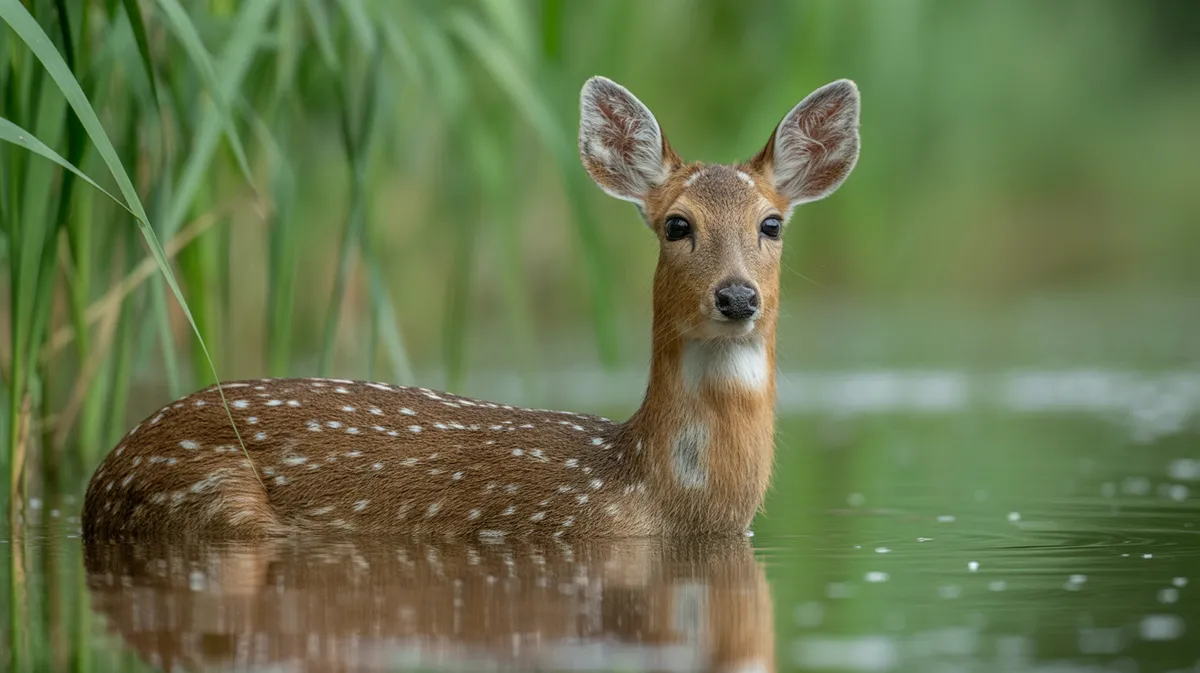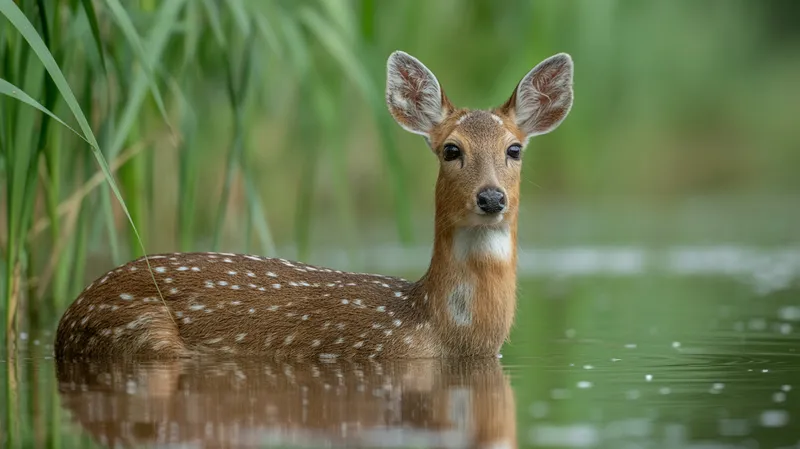
Water Deer
Hydropotes inermis

Meet the Water Deer
The Water Deer is a small, unique species of deer native to eastern China and the Korean Peninsula. Unlike most deer, it lacks antlers and instead possesses prominent, downward-pointing tusks, especially noticeable in males. This deer is well-adapted to wetland habitats, being a strong swimmer and often found in reed beds, marshes, and along rivers. Its solitary, secretive behavior and excellent camouflage make it difficult to observe in the wild.
Classification
Mammal
Habitat
Wetlands, reed beds, marshes, and riverbanks
Diet
Herbivore
Lifespan
10-12 years
Conservation
Vulnerable
Weight
9–14 kg
📖Fascinating Facts
Tusked Males
Male water deer possess long, sharp upper canine teeth that can grow up to 8 cm, which they use in combat with rivals.
Wetland Dwellers
Water deer prefer habitats with dense vegetation near water, such as reed beds and marshes, providing both food and protection from predators.
High Reproduction Rate
Female water deer can give birth to as many as 2–7 fawns at a time, one of the highest litter sizes among deer species.
📋Detailed Description
The water deer (Hydropotes inermis) is a small, primitive member of the deer family, notable for its lack of antlers and the presence of elongated upper canine teeth, or 'tusks,' particularly pronounced in males. Adults typically measure 75–100 cm in body length, stand 45–55 cm at the shoulder, and weigh between 9–14 kg, with males slightly larger than females. Their coat is coarse and ranges from yellowish-brown to grayish-brown, with a paler underbelly and a distinctive, fluffy rump patch. Water deer possess a relatively short tail and long, slender legs adapted for moving through dense vegetation and swimming. Their large, rounded ears and prominent eyes provide acute hearing and vision, aiding in predator detection. Unlike most cervids, water deer have a simple stomach and lack the facial glands used for scent marking. They are solitary or form loose associations, especially during the breeding season. Their secretive nature and cryptic coloration make them difficult to observe in the wild. Water deer are highly territorial, with males establishing and defending territories using their tusks in ritualized combat.
💡 Did you know?
Despite their small size and lack of antlers, male water deer fiercely defend their territories using their long tusks during the breeding season.
🔬Research & Sources
Wikipedia Summary
The water deer is a small deer species native to Korea and China. Its prominent tusks, similar to those of musk deer, have led to both subspecies being colloquially named vampire deer in English-speaking areas to which they have been imported. It was first described to the Western world by Robert Swinhoe in 1870.
Last Modified: 5/24/2025
🎭Behavior & Social Structure
Water deer are primarily crepuscular, being most active during dawn and dusk. They are solitary for much of the year, with both sexes maintaining overlapping home ranges, although males become highly territorial during the rut. Feeding involves selective browsing and grazing on a variety of herbaceous plants, reeds, grasses, sedges, and aquatic vegetation. They are adept swimmers and will readily enter water to escape predators or move between habitat patches. Males use their tusks in aggressive displays and fights over territory or access to females, often resulting in superficial wounds. Scent marking is minimal compared to other deer, and communication relies more on vocalizations, body postures, and physical confrontations. Water deer are vigilant and rely on their keen senses to detect threats, quickly fleeing into dense cover or water when alarmed.
👶Reproduction & Life Cycle
The breeding season (rut) occurs from November to January. Males establish and defend territories, engaging in fierce tusk-to-tusk combat for mating rights. After a gestation period of approximately 6–7 months (typically 180–210 days), females give birth to litters of 1–7 fawns, with 2–3 being most common. Births occur in dense vegetation from May to July. Fawns are precocial, born with spotted coats for camouflage, and remain hidden for the first few weeks of life. The mother visits them briefly to nurse, minimizing scent trails to avoid predation. Weaning occurs at about 3 months, and young become independent by autumn. Sexual maturity is reached at about 6–7 months, though most individuals breed in their second year.
🛡️Adaptations & Survival
Water deer exhibit several unique adaptations for their wetland habitats. Their long legs and lightweight build facilitate movement through dense reeds and marshes, while their strong swimming ability allows them to cross rivers and flooded areas with ease. The absence of antlers is compensated by the development of elongated upper canines, which are used in intraspecific combat and display. Their cryptic coloration and secretive behavior aid in avoiding predators. Water deer have a high reproductive output, with large litters uncommon among deer, likely as an adaptation to high predation rates on fawns. Their digestive system is adapted for a diet high in fibrous aquatic and marsh vegetation.
🎨Cultural Significance
In East Asian cultures, water deer have been hunted for their meat and for the use of their tusks and other body parts in traditional medicine, though they are less prominent in folklore than other deer species. Their unusual appearance has led to nicknames such as 'vampire deer' in the West, especially in regions where they have been introduced. In the UK, feral populations have become a curiosity and are sometimes featured in wildlife documentaries and local folklore.
🔬Recent Research & Discoveries
Recent studies have focused on the genetic diversity and population structure of water deer, particularly in fragmented habitats. Research has also examined the ecological impact of introduced populations in Europe, where they may compete with native species or alter wetland ecosystems. Behavioral studies have detailed the function of tusks in social interactions and the species' high reproductive rate. Ongoing conservation research aims to improve habitat management and develop monitoring techniques, such as camera trapping and genetic sampling, to better assess population trends.
🎥Wildlife Videos

The Secret Life of Water Deer: Nature's Hidden Gem
Dive into the fascinating world of water deer in "The Secret Life of Water Deer: Nature's Hidden Gem." This captivating exploration ...
World Wonders

Rivers of Death (Full Episode) | World's Deadliest
Rivers bring water, the element essential to all life. But wherever they flow, killers prowl, hidden just below the surface waiting to ...
Nat Geo Animals

Secrets of the Wild - Following Deer Through the Seasons | Full Documentary
Deer are instantly recognisable and much-loved symbols of the wild, but how well do we really know them? Over the course of a ...
Free High-Quality Documentaries

The Wonder of America's National Parks | MEGA EPISODE Season 1 Full Episode
America's National Parks depicts the adventure, beauty and wonder of natural spaces. Each park is a valuable and important ...
National Geographic

The Mystical Life of Deer and the Discovery of a White Deer | Full Episode
30 million white-tailed deer live in the United States. They have begun to adapt themselves to living in a world of traffic, pets and ...
Free High-Quality Documentaries

The Baltic | Survival in a Pristine Ecosystem | Animal documentary
Welcome to "The Baltic | Survival in a Pristine Ecosystem", a captivating wildlife documentary that transports you to the serene yet ...
WILD NATURE - Nature animal documentary
🌍Habitat Information
The Water Deer typically inhabits Wetlands, reed beds, marshes, and riverbanks environments. Water Deers have adapted to their environments with specialized features and behaviors.
Primary Habitat:
Wetlands, reed beds, marshes, and riverbanks
More detailed habitat information will be available soon.
🛡️Conservation Status
The Water Deer is currently classified as Vulnerable. Conservation efforts are crucial for preserving this species for future generations.
Common Threats:
- 🏠Habitat loss and fragmentation
- 🌡️Climate change impacts
- 🎯Hunting and poaching
- 🏭Human-wildlife conflict
⚠️Threats & Conservation Challenges
Water deer populations are threatened by habitat loss due to wetland drainage, agricultural expansion, and urbanization. Hunting for meat and traditional medicine, as well as accidental deaths from poaching and snares, further impact numbers. Invasive plant species and changes in water management can degrade their preferred habitats. The global population is fragmented, with strongholds in eastern China and the Korean Peninsula, and introduced populations in the United Kingdom and France. The IUCN lists the species as Vulnerable, with declining trends in native ranges but some stability or increase in introduced populations. Conservation is challenged by the species' secretive nature and lack of comprehensive population data.
🔬Scientific Classification
Scientific Name
Hydropotes inermis
Classification Hierarchy
🔍 About Taxonomic Classification
Taxonomic classification is a hierarchical system used by scientists to classify and organize living organisms based on shared characteristics and evolutionary relationships.
The system moves from broad categories (Kingdom) to increasingly specific ones, with each animal's scientific name typically consisting of its Genus and species.
📝Community Notes
Share your observations and insights about the Water Deer with our community of wildlife enthusiasts.
Join Our Community
Sign in to share your observations and connect with fellow wildlife enthusiasts.
Sign In to ContributeNo community notes yet
Be the first to share your observations about the Water Deer!
Explore Water Deer
Select a tab above to learn more about this amazing animal.
📸Photo Gallery
No photos available for this animal yet.
🌟Discover More Wildlife
Continue your journey of discovery with more fascinating animals from our database
